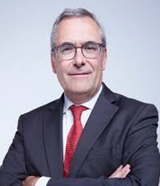Liquidity, liquidity, liquidity.
That was the recurring theme of discussions at a Single Resolution Board (SRB) meeting on bank resolvability in Brussels on October 15.
| Dominique Laboureix: “We need a solution with some support from those that are able to provide liquidity” |
“Liquidity is not well covered by the regulatory framework. This is the missing element,” admitted Dominique Laboureix, member of the board and director of resolution planning and decisions at the SRB. “This is well recognised now by all stakeholders. It is not enough to work on private sources of funding. We need a solution with some support from those that are able to provide liquidity to finalise decisions that we can make at SRB level: the central banks.”
It is clear, two and a half years after the implementation of the Bank Resolution and Recovery Directive (BRRD) in January 2016 that there is still an awful lot of work to be done to make the regulation achieve its aims.
“Banks are now more resolvable, but are they resolvable? We are somewhere in the middle of the process; there is still work to be done,” agreed Ignazio Angeloni, member of the supervisory board at the European Central Bank. “In order to have resolution, banks need good preparation, good legislation and appropriate funding. Good preparation has been done by the SRB, good rules and legislation have been provided by BRRD. But there are issues here that have to be thought through.”
The most important issue now is funding in resolution.
The idea of centralised emergency liquidity assistance for banks in difficulty has been on the agenda for a while. It would essentially turn the ECB into a single European lender of last resort. Angeloni is less than enthusiastic about this.
| Ignazio Angeloni: “There are issues here that have to be thought through” |
“Should the ECB be the lender in every resort?” he asked. “The ECB has very clear boundaries on how liquidity can be provided. It has to be part of the tasks of the ECB, and adequate collateral must be provided. Liquidity could be provided by the ECB but it comes with conditions, one of which is that the bank has to be solvent.”
Angeloni compared the position of the ECB with that of the FDIC in the US, which can tap the resources of the US Treasury and the orderly liquidation fund as soon as a bank is placed into receivership.
The ECB would like to see an enlarged Single Resolution Fund with an emergency backstop. This idea has been kicked around for a while.
The SRF was $25 billion in size at the end of June this year and will grow to just short of €33 billion by 2019. Just 1% of covered deposits in the EU – its goal – would be around $60 billion.
The key sticking point, however, seems to be the backstop. A €60 billion backstop has been agreed but is widely seen to be insufficient.
“Even etymologically, €60 billion is not a backstop,” Angeloni sniffed.
One of the strongest calls for a backstop came from an institution uniquely qualified to comment on European bank resolution: Banco Santander. The Spanish bank’s takeover of struggling rival Banco Popular in June last year is the single example of BRRD actually being implemented.
It has been dogged by controversy and legal challenges. During the SRB meeting Elke König, SRB chair, revealed that 12,000 responses have been lodged for its “right to be heard” procedure concerning the resolution.
Belén Romana García, an independent non-executive director at Banco Santander, suggests that the resolution of Banco Popular and its takeover by Santander for €1 was a case of first time lucky.
“There has been a lack of coherence,” she said. “Liquidity was a huge issue – not only before the takeover but immediately afterwards as well. We were lucky that Banco Popular had been trying to get new shareholders as that meant that we could get a look at the bank. [The] Banco Popular [situation] made clear that there is a need for a funding backstop. It will give everyone more time and things will be easier. We do need this funding backstop. You cannot have a premeditated amount if it is a backstop. We do need it and it should be fast.”
Getting support for the concept of unlimited funding for failing banks across Europe will not be easy. The proposal for an increased and backstopped SRF is only due to come into force in 2024, and even then will require approval on a case-by-case basis.
Philippe Lamberts, MEP for the Group of the Greens/European Free Alliance at the European Parliament, expressed his frustration during the SRB meeting.
“The resolution fund is sufficient to fund one or two resolutions at most. The backstop should be a wall of money – not €60 billion,” he declared. “We are being offered something for 2024, but a system where you need to summon the Bundestag over the weekend to vote is constructed in a way that makes its engagement not credible.
“Do we want to have a banking union that includes resolution?” he asked. “If we want that, we have to go all the way. We have the first pillar of banking union [supervision]. We have a half-baked second pillar [resolution] and as for the third pillar [deposit insurance] – forget it. I am mad. I supported BRRD all the way. When I see where we are today, it is very disappointing.”
For more on the evolution of bank resolution in Europe see the November issue of Euromoney


 Signal2forex.com - Best Forex robots and signals
Signal2forex.com - Best Forex robots and signals




